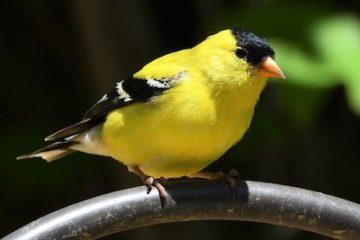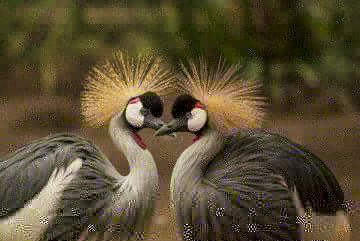by Mary Hrovat

I love birds, and I’m obsessed with words, so I suppose it stands to reason that I’m fascinated by the names of birds. I enjoy the “what it says, it does” names such as gnatcatcher and wagtail. (Further investigation reveals that the gnatcatcher family includes gnatwrens such as the chattering gnatwren and the trilling gnatwren, who I assume also do what their names say.) There are also bee-eaters and brushrunners, leaftossers and treecreepers, berrypeckers and foliage-gleaners.
Rollers perform acrobatic flight maneuvers to woo a mate or protect their territory. Bowerbirds build elaborately decorated structures to attract a mate, and some ovenbirds (furnariids) build nests of clay that roughly resemble tiny ovens. Weavers are known for their intricately constructed nests, which they build by weaving grasses and other types of vegetation.
I also delight in names that describe a bird’s appearance: the checker-throated stipple throat and the harlequin duck, for example. The male twelve-wired bird-of-paradise has twelve wiry filaments near his rear that he uses in his courtship display. The prothonotary warbler was named for a yellow-robed notary at the Byzantine court. The rainbow-bearded thornbill is a hummingbird with a narrow glittering band along its gorget (throat feathers) that ranges in color from green to red (more visible in the males than in the females).

Many birds are refulgent: the shining drongo and shiny cowbird, sparkling violetear, glistening-green tanager and glossy antshrike, and various hummingbirds known as brilliants. Other names describe the sound of a bird: the northern screamer, clamorous reed warbler, mewing kingfisher, chirruping wedgebill, snoring rail, and mute swan.
Some names are simply magical: the chanting goshawks, for example (pale and dark), the flutist wren and the mossy-nest swiftlet and the agile tit-tyrant. Some birds sound like they belong in an office: the secretarybird, the fiscal flycatcher, and the lettered aracari (Pteroglossus inscriptus, named for markings on its bill).
Other names say more about humans than they do about the bird. The barnacle goose is so named for a long-standing folk belief that it hatches out of goose barnacles (of course) on rotting wood near shore. The names happy wren, joyful greenbul, placid greenbul, and stolid flycatcher may also be human projections. As Edward Abbey said about aspen trees, we don’t know what these birds call themselves.
And I must admit that I enjoy the names of some birds simply for the sound of them: the boat-tailed grackle, the buff-spotted flufftail and buff-thighed puffleg, the rosy starling, the star-spotted nightjar, and the nunlets. I also like the scientific name of the Eurasian hoopoe: Upupa epops.
###
The colors of birds are the result of either pigmentation, the refraction of light by the feathers (this is called structural color), or a combination of the two. The roseate spoonbill and greater flamingo, among other birds, get their pink color from carotenoids in the food they eat. The preen oil produced by the uropygial gland of the greater flamingo also contains carotenoids; when the birds spread the preen oil over their feathers, it deepens their natural color. They reportedly do this more often when they’re preparing to mate.
The iridescence in the plumage of starlings and the gorgets of many hummingbird species is a type of structural color resulting from the refraction of light by structures in the feathers. Seen at certain angles, for instance, the face and gorget of the male Anna’s hummingbird show dazzling iridescent colors; at other angles, they appear dark. The color of most blue feathers is also due to refraction rather than pigmentation, specifically, refraction by air pockets in the feathers.
Colors might be among the most poetic descriptors applied to birds. There are not only blue birds, for example, the blue jay, blue petrel, and blue waxbill, but also the bluish flowerpiercer, the bluish-slate antshrike, and the steel-blue flycatcher. We also need the words ultramarine (a grosbeak and a kingfisher, for example), cerulean (e.g., the cerulean warbler and cerulean-capped manakin), cobalt (the cobalt-winged parakeet), indigo (a bunting, a flycatcher, a flowerpiercer), and azure (for example, the azure dollarbird and the azure-naped jay).

The range of brown(ish) and reddish-brown colors in birds is considerable. Brown is not precise enough to describe the tawny owl, chestnut-banded plover, cinnamon bittern, fawn-coloured lark, chocolate-backed kingfisher and cocoa thrush, russet sparrow, ruddy turnstone, or rusty-collared seed-eater. There are black and blackish birds, but also the sooty swift, sooty albatross, and sooty-capped hermit, among many sooty birds; the coal tit and coal-crested finch; the dusky sunbird (which seems like an oxymoron), dusky antbird, and dusky-tailed flatbill, among dusky birds. Birds with gray or grey in their names include the gray thrasher, grey crow, and greyish mourner. But then there are the ashy bulbul, ashy storm petrel, ashy-faced owl, and ashy-throated warbler, as well as the slaty bristlefront, great slaty woodpecker, and slaty-backed hemispingus. Not to mention the smoke-colored pewee.
There is a glorious range of red, pink, and orange coloration in birds: the vermilion flycatcher, crimson chat, scarlet robin, and carmine bee-eaters (northern and southern); the salmon-crested cockatoo, peach-fronted parakeet, and apricot-breasted sunbird. The cardinal lory, a bright, almost completely red bird, is named for its color; the name of the color cardinal refers to the robes worn by cardinals in the Catholic Church. The northern cardinal of North America is also supposedly named for the churchmen. Fiery red birds include the green-backed firecrown, fire-bellied woodpecker, firethroat, fringe-backed fire-eye, fiery-browed starling, flamecrest, and flame-eared honey-eater. The flamingo also gets its name from the Latin word for flame.
Bird names are full of old-fashioned descriptive terms derived from Latin. The hepatic tanager is a brownish-red liver color. The flammulated owl has flame-like markings. The rufous (reddish) birds include the rufous crab hawk, rufous-winged buzzard, great rufous woodcreeper, and green-and-rufous kingfisher. (For a while it seemed that everyone knew the rufous-sided towhee, but that species has been split into the eastern towhee and the spotted towhee.)
Ferruginous birds, like the ferruginous pygmy owl, are rust-colored; the word comes from the Latin word for iron. Plumbeous birds, on the other hand, are a leaden gray: the plumbeous ibis, for example, and the plumbeous euphonia (a songful gray bird). Cinereous birds like the cinereous finch are an ashy gray. The male vinaceous rosefinch is a lovely wine-colored bird.
Hummingbirds are among the most jewel-like of birds, and their names reflect this. Among the hummingbirds, there are various mountaingems, sapphires, and topazes, and a great many emeralds, including the sumptuously named sapphire-spangled emerald and the golden-crowned emerald, as well as the endearingly humble garden emerald. (Somewhat surprisingly, there is also a sombre hummingbird.) Other jewel-named birds include the pearl-breasted swallow and pearly-bellied seedeater, garnet pitta, beryl-spangled tanager, Himalayan ruby-throat, and lazuli bunting.
###

In the 4.5-billion-year history of Earth, birds have been around for only about 60 million years. We’re extraordinarily fortunate to share the planet with these beautiful, vocal, and highly various animals and to have their lives going on alongside ours. We humans think we’re pretty special because we’ve been to the moon and split the atom, but none of us can boast azure shoulders (like one type of tanager), much less an opal rump (another tanager), an amethyst throat (a mountaingem), a lemon breast (a canary), a purple nape (a lory and a sunbird), a maroon chest (a ground dove), blue feet (a booby), a crimson brow (a finch), or a silver crown (a friarbird).
The plain bush-hen, drab whistler, and shy heathwren are also marvelous animals. Shyness and obscurity can be valuable traits in a world of predators, especially a world of humans. Given the way we’ve treated birds and the environment that we share with them, I often think we don’t deserve the company of birds. I wonder what the lives of birds would be like if we were gone.
###
Image of rainbow lorikeet by sandid from Pixabay
Image of American goldfinch by Miles Moody from Pixabay
Image of grey crowned cranes by Frank Winkler from Pixabay
Image of ruddy shelduck by Robert Balog from Pixabay
###
You can see more of my work at MaryHrovat.com.
